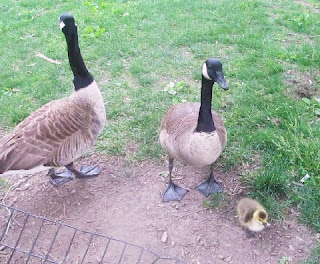It is virtually impossible to get through an entire spring in New York City's Central Park without some casualties to our park geese and ducks.
This spring was no exception as losses occurred to newly hatched goslings and one long-time domestic duck. Additionally, a number of goose eggs failed to hatch.
But, all in all, it's was a comparatively peaceful and even cheerful spring as Central Park's geese were free from harassment this year and at least three mated goose couples produced healthy offspring. (One pair from the Reservoir and two couples from the Boat Lake.)
Though gosling numbers are still low in Central Park (only seven in total), reality is, that if the babies make it through the first couple of weeks, chances vastly improve for their ultimate survival.
I was not optimistic that a tiny, lone gosling to one of the Boat Lake goose pairs would survive as s/he had no siblings to huddle and grow up with. But at the same time this little one hatched (in early June) a nearby goose couple hatched three goslings and the two families have stayed together ever since.
I initially speculated that the two mother geese are likely sisters and this was the reason for the two families to raise their babies in close proximity to each other. But it's also probable that the couple with only one baby made conscious decision to stay close to the family with three in order to ensure better survival odds to their only hatchling. Four adult geese together can, after all, defend better against potential predators (such as raccoons) than only two.
Though all four goslings are often observed intermingling and grazing together, each baby is clearly imprinted to his/her parents. At the end of the day, the one gosling is always with his parents and the other three with theirs. There is clear division between the two families though they remain close.
One of the things impressive about the two new goose families at Central Park's Boat Lake is their ease and comfort around people. This is particularly true of the mother geese (who determine nesting sites) and further suggests they are not only sisters, but likely hatched themselves at the Boat Lake some years ago. (They are likely the offspring of long-time resident goose pair, Man and Lady who still remain at the lake.)
It is remarkable to see the two families comfortably grazing daily at a small lawn near the Ladies Pavilion that is a popular attractant to tourists and other park goers. Fortunately, for the geese and their babies, virtually all the people have demonstrated respect and kindness, stopping mostly to photograph the two families. Certainly, the geese have proven themselves to be a popular tourist attraction to Central Park.
Though the mother geese are particularly at ease with people, their ganders are far more wary. -- Especially the gander I named, "Zeus" who is the daddy to the one gosling. Zeus appears to be the sentry goose for both families, always keeping watchful eye and rarely stopping to graze. (Zeus also looks like he's been in some past battles to secure the affections of his mate, Zorra as evidenced by old, torn feathers on his chest.)
Meanwhile, back at Central Park's Reservoir, the three older goslings (hatched on May 8th, to experienced goose pair, Hansel and Greta) are now half grown and starting to show assertiveness, particular bonding to the same sex parent and some independence. I have speculated for some time that the three are composed of two girls and one boy. It was therefore not surprising yesterday to note two of the goslings swimming with Greta and one, (presumably the boy), swimming with Hansel. This particular gosling has also demonstrated mimicking of his dad's behavior by chasing ducks and even other geese from the family's grazing area.
It is amazing to think that Canada geese go, in three short months, from tiny yellow balls of fluff no bigger than a tennis ball to fully grown birds capable of flight. So much they have to learn in that small window of time and so fast they have to develop.
If all goes according to past patterns, the three Reservoir goslings will be flying by eleven weeks and will leave the Reservoir with their parents by the first week in August.
The family will not be seen again until next March when (hopefully) all five will return to the Reservoir again for the parents to begin the next nesting process.
But don't ask me where the family goes between August and March.
There are just some secrets the geese aren't willing share with me. -- PCA
**************































